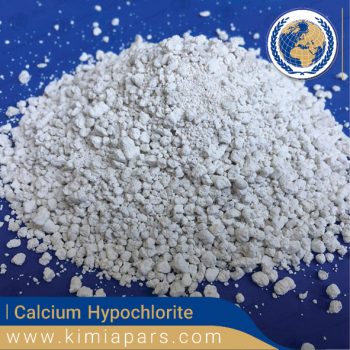Calcium Hypochlorite 65%
- Description
- Analysis of Calcium hypochlorite
- Safety Conditions
Description
Calcium Hypochlorite 65%
Chemical Formula of Calcium Hypochlorite 65%: Ca(ClO)2
Other names: Perchlorine | Hypochlorous acid | Calcium salt | Bleaching powder | Calcium oxychloride | Pittclor | Caporit | Calcium hypochlorite dihydrate
Appearance: White Granules
Other usages
- Sanitizing public swimming pools and spa
- Waste water and effluent treatment
- Cleaning and sanitizing (Bathroom cleansers | Household disinfectant sprays | Algaecides | Herbicides )
- Anti fungal
- Anti bacterial (anti-odor)
- Herbicides
- Laundry detergents
- Food and beverage processing (Vegetables disinfectant)
- Laundry
- Pulp and paper processing
- Disinfects drinking water
- CIP
- Grey water and recycled water treatment (storage tanks)
Packaging: 40,45,50 Kg PE drums
Price: Negotiable, depending on the amount of the order
Payment terms: T/T 100% cash in advance
Min order: 1* 20 ft. FCL
Delivery time: Within 5-10 days after we receive the payment
Origin: Iran
Calcium Hypochlorite: An Overview
Calcium hypochlorite is a chemical compound with the formula Ca(ClO)2. It is commonly known as bleach powder, chlorinated lime, or pool shock. Calcium hypochlorite is a white, crystalline powder that is highly soluble in water and releases chlorine when dissolved. This makes it an effective and efficient solution for a variety of applications, including water treatment, sanitization, and bleaching.
In its pure form, calcium hypochlorite is a powerful oxidizing agent that can generate dangerous levels of heat and pressure. For this reason, it is typically sold as a 68% or 70% solution, which contains a lower concentration of active chlorine and is safer to handle and use.
Uses in the Industries
-
Water Treatment
Calcium hypochlorite is widely used in the water treatment industry for the disinfection of drinking water, swimming pools, and wastewater. When added to water, it releases chlorine, which kills bacteria, viruses, and other harmful microorganisms. This helps to ensure that the water is safe for human consumption and reduces the risk of waterborne diseases.
In addition, calcium hypochlorite is also used to treat water in industrial and agricultural applications, helping to reduce the risk of contamination and improve the quality of the water.
-
Sanitization
Calcium hypochlorite is used in the food and beverage industry for sanitization purposes. When added to food and beverage processing equipment, it helps to kill bacteria and other harmful microorganisms, reducing the risk of contamination and improving the safety of the food and beverage.
In addition, calcium hypochlorite is also used in the healthcare industry for sanitization purposes. It is added to surfaces, equipment, and instruments to kill bacteria and other harmful microorganisms, reducing the risk of infection and improving overall hygiene.
-
Bleaching
Calcium hypochlorite is used in the textile and paper industry for bleaching purposes. When added to textile fibers and paper, it helps to remove impurities, brighten colors, and improve the overall appearance and quality of the product.
In addition, calcium hypochlorite is also used in the food industry for bleaching purposes. It is added to flour, sugar, and other food products to improve their appearance and reduce the risk of discoloration.
Safety Considerations
Calcium hypochlorite is a powerful oxidizing agent that can generate dangerous levels of heat and pressure. For this reason, it is important to handle and use calcium hypochlorite with caution.
When handling calcium hypochlorite, it is important to wear protective gloves and eye protection to reduce the risk of skin and eye irritation. In addition, calcium hypochlorite should be stored in a cool, dry place, away from heat and moisture, to reduce the risk of decomposition and the release of dangerous levels of chlorine gas.
It is also important to avoid mixing calcium hypochlorite with other chemicals, as this can generate dangerous levels of heat and pressure and increase the risk of fire or explosion. This includes mixing calcium hypochlorite with acids, such as vinegar or citric acid, as this can generate chlorine gas.
Conclusion
Calcium hypochlorite is a versatile and effective solution for a variety of applications, including water treatment, sanitization, and bleaching. Despite its many benefits, it is important to handle and use calcium hypochlorite with caution to reduce the risk of skin and eye irritation, decomposition, and the release of dangerous levels of chlorine gas.
Calcium hypochlorite Analysis |
| Content | Test Result |
|---|---|
| Av.chlorine | Min 66 %w/w |
| Nacl | 15-20 %w/w |
| Solubility (As.av.chlorine) | Min 55 %w/w |
| Insoluble in water | Max 8 %w/w |
| H2O | 2-8 %w/w |
| As | Max 0.1 mg/kg |
| Cd | Max 0.1 mg/kg |
| Cr | Max 8 mg/kg |
| Hg | Max 0.1 mg/kg |
| Ni | Max 0.1 mg/kg |
| Pb | Max 0.5 mg/kg |
| Sb | Max 0.1 mg/kg |
| Se | Max 0.1 mg/kg |
| Fe | Max 0.1 mg/kg |
| Remain on mesh 425 micron | Min 75 %w/w |
| Remain on mesh 2mm | Min 20 %w/w |
-Oxidizing and Corrosive
-Keep in cool and dry place and away from direct sun light, combustible material, reducing oxidizing and corrosive materials, organic materials, acids, moisture, heat sources, sparks, flame, flammable materials, organic material and fossil fuels.
-In case of ignition, put out by water.
-Do not mix with any chemicals.
-Contact with acids emits toxic gases.
-In case of contact with eyes ,nasal mucous and mouth, immediately flush them with plenty of water.
-If swallowed consult a physician.
-Keep out of reach of children.

